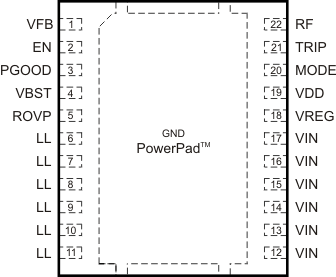ZHCS979G June 2012 – November 2025 TPS53318 , TPS53319
PRODUCTION DATA
5 引脚配置和功能
 图 5-1 22 引脚 DQP (LSON-CLIP) 封装(顶视图)
图 5-1 22 引脚 DQP (LSON-CLIP) 封装(顶视图)表 5-1 引脚功能
| 引脚 | 类型(1) | 说明 | ||
|---|---|---|---|---|
| 名称 | 编号 | |||
| EN | 2 | I | 使能引脚。典型导通阈值电压为 1.3V。典型关断阈值电压为 1.0V。 | |
| GND | G | 器件的接地和散热焊盘。使用适当数量的过孔连接到接地平面。 | ||
| LL | 6 | B | 转换后电源的输出。将该引脚连接到输出电感器。 | |
| 7 | ||||
| 8 | ||||
| 9 | ||||
| 10 | ||||
| 11 | ||||
| 模式 | 20 | I | 软启动和模式选择。连接一个电阻器以使用表 7-3 选择软启动时间。启动期间会检测软启动时间并将其存储在内部寄存器中。 | |
| PGOOD | 3 | O | 开漏电源正常标志。在 VFB 降至指定限值范围内后提供 1ms 的启动延迟。当 VFB 超出指定限值范围时,PGOOD 在 2µs 延迟后变为低电平。 | |
| ROVP | 5 | I | 冗余过压保护 (OVP) 输入。使用电阻分压器将此引脚连接至 VOUT。通过 1.5MΩ 电阻器在内部下拉至 GND。如果不需要冗余 OVP,请将该引脚连接到 GND。不要让 ROVP 引脚悬空(请参阅节 7.3.9)。 | |
| RF | 22 | I | 开关频率选择。将电阻器连接到 GND 或 VREG,以使用表 7-1 选择开关频率。启动过程中会检测和存储开关频率。 | |
| TRIP | 21 | I | OCL 检测阈值设置引脚。室温下 ITRIP = 10µA。提供 3000ppm/°C 的电流,并按以下要求设置 OCL 跳变电压。 | |
| VOCL = VTRIP/32 | (VTRIP ≤ 2.4V,VOCL ≤ 75mV) | |||
| VBST | 4 | P | 高侧 FET 栅极驱动器(升压端子)的电源输入。在该引脚和 LL 节点之间连接电容器。通过自举 MOSFET 开关在内部连接到 VREG。 | |
| VDD | 19 | P | 控制器电源输入。VDD 输入电压范围为 4.5V 至 25V。 | |
| VFB | 1 | I | 输出反馈输入。通过电阻分压器将此引脚连接至 VOUT。 | |
| VIN | 12 | P | 转换电源输入。转换输入电压范围为 1.5V 至 22V。 | |
| 13 | ||||
| 14 | ||||
| 15 | ||||
| 16 | ||||
| 17 | ||||
| VREG | 18 | P | 5V 低压降 (LDO) 输出。为内部模拟电路和驱动器电路供电。 | |
| 散热焊盘 | G | 器件的接地和散热焊盘。使用适当数量的过孔连接到接地平面。 | ||
(1) I = 输入,O = 输出,B = 双向,P = 电源,G = 接地